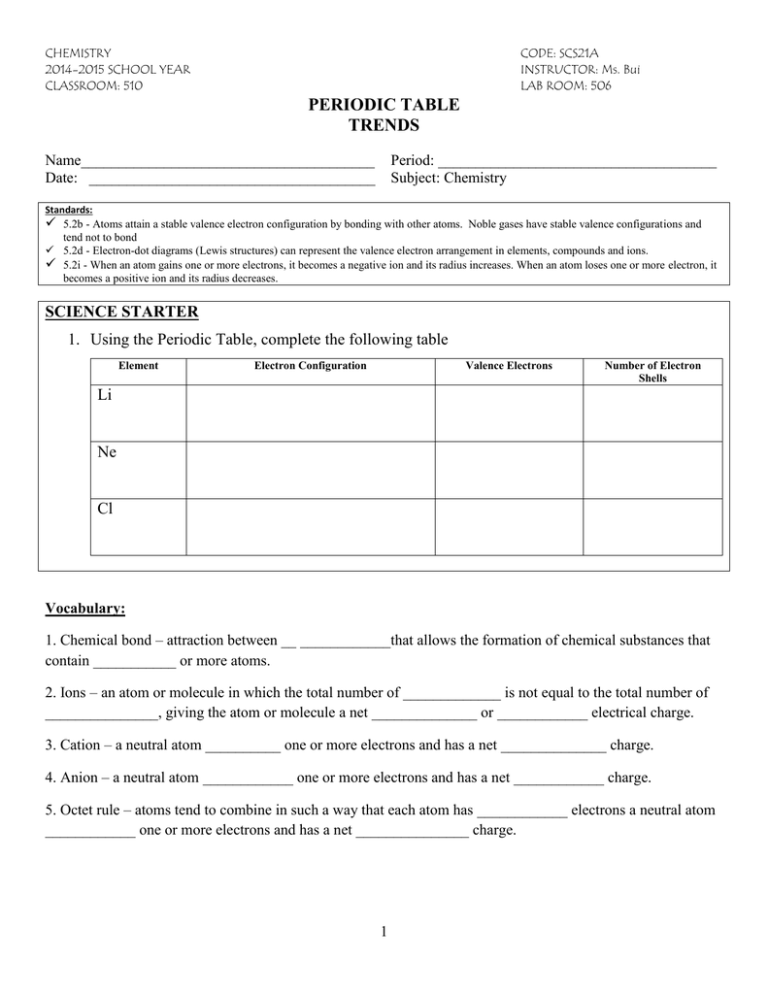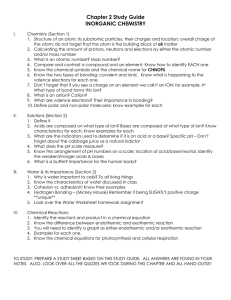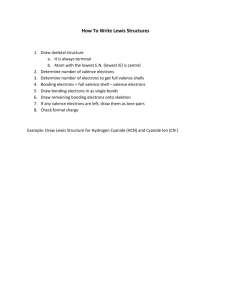Chemical-Bonds-1
advertisement

CHEMISTRY 2014-2015 SCHOOL YEAR CLASSROOM: 510 CODE: SCS21A INSTRUCTOR: Ms. Bui LAB ROOM: 506 PERIODIC TABLE TRENDS Name_______________________________________ Date: ______________________________________ Period: _____________________________________ Subject: Chemistry Standards: 5.2b - Atoms attain a stable valence electron configuration by bonding with other atoms. Noble gases have stable valence configurations and tend not to bond 5.2d - Electron-dot diagrams (Lewis structures) can represent the valence electron arrangement in elements, compounds and ions. 5.2i - When an atom gains one or more electrons, it becomes a negative ion and its radius increases. When an atom loses one or more electron, it becomes a positive ion and its radius decreases. SCIENCE STARTER 1. Using the Periodic Table, complete the following table Element Electron Configuration Valence Electrons Number of Electron Shells Li Ne Cl Vocabulary: 1. Chemical bond – attraction between __ ____________that allows the formation of chemical substances that contain ___________ or more atoms. 2. Ions – an atom or molecule in which the total number of _____________ is not equal to the total number of _______________, giving the atom or molecule a net ______________ or ____________ electrical charge. 3. Cation – a neutral atom __________ one or more electrons and has a net ______________ charge. 4. Anion – a neutral atom ____________ one or more electrons and has a net ____________ charge. 5. Octet rule – atoms tend to combine in such a way that each atom has ____________ electrons a neutral atom ____________ one or more electrons and has a net _______________ charge. 1 Part 1: Draw Lewis Dot Structure for Atoms Element Lewis Dot Structure Li Ne Cl Mg Part 2: Draw ions Element Lewis Dot Structure Lithium ion Chloride ion Oxygen ion Magnesium ion 2 Symbol Question: 1. What is the difference between an atom and an ion? 2. How many valence electrons does a chlorine atom have? 3. How many valence electrons does a chloride ion have? 4. Using the table above, name one cation and one anion. 5. Lithium is part of what group? What is the trend for elements in this group in terms of forming ions? 6. Chlorine is part of what group? What is the trend for elements in this group in terms of forming ions? 7. Based on the number of valence electrons for each element, why don’t elements in the Noble Gas Group readily form compounds with other elements? 3 AIM Prompt: In a chemical reaction between lithium and chlorine, what types of ions will be formed? State your claim and provide evidence. ___________________________________________________________________________________ ___________________________________________________________________________________ ___________________________________________________________________________________ ___________________________________________________________________________________ ___________________________________________________________________________________ ___________________________________________________________________________________ ___________________________________________________________________________________ ___________________________________________________________________________________ ___________________________________________________________________________________ ___________________________________________________________________________________ ___________________________________________________________________________________ ___________________________________________________________________________________ 4







